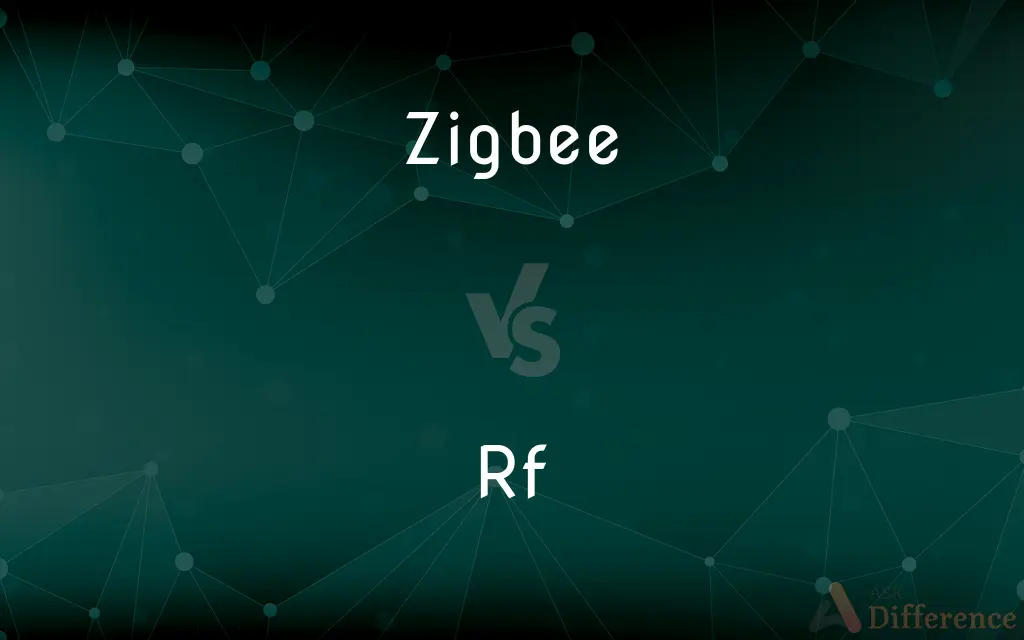Zigbee vs. Rf — What's the Difference?
By Maham Liaqat & Urooj Arif — Updated on April 8, 2024
Zigbee is a specification for a suite of high-level communication protocols using low-power digital radios, while RF refers to radio frequency, a range of electromagnetic frequencies.

Difference Between Zigbee and Rf
Table of Contents
ADVERTISEMENT
Key Differences
Zigbee is a technology that operates in the IEEE 802.15.4 personal area network standard, specifically designed for low-data-rate networks and utilizes low-power digital radios for communication. It is widely used in applications requiring low power consumption and low bandwidth, such as smart homes and IoT devices. On the other hand, RF (Radio Frequency) encompasses a broad spectrum of electromagnetic frequencies used for wireless communication, including but not limited to television broadcasting, mobile phones, and radio communications. RF technology is the foundation upon which systems like Zigbee are built, serving a wider range of applications and devices.
One of the key differences between Zigbee and RF technology lies in their scope and application. Zigbee, being a specific protocol within the RF spectrum, is tailored for short-range communication and is optimized for small-scale networks with a focus on minimizing power consumption. Conversely, RF technology covers a vast range of frequencies and is utilized in a variety of applications beyond short-range communication, from microwave ovens to satellite transmissions. This distinction highlights Zigbee's role as a solution for specific use cases within the broader context of RF communication.
Zigbee networks are characterized by their ability to form mesh networks, allowing devices to communicate with each other through intermediate devices, extending their range and reliability. This mesh networking capability is integral to Zigbee's design, facilitating robust communication in environments where direct communication between all devices is not feasible. In contrast, RF communication does not inherently include a networking protocol or topology, as its application can range from simple point-to-point communication to complex broadcasting systems, depending on the specific technology employed (e.g., Wi-Fi, Bluetooth).
In terms of power consumption and efficiency, Zigbee protocols are engineered to ensure that devices can operate on a small amount of power for extended periods, making it ideal for battery-operated devices in a smart home environment. RF technology, given its broad application, does not have a uniform approach to power consumption, with some applications requiring significant power for long-distance transmission, while others, like NFC (Near Field Communication), operate with very low power over short distances.
Zigbee's security features are designed to cater to the needs of secure, low-power networks, incorporating features such as AES-128 encryption. While RF communication also includes security measures, the specific implementation varies widely among different RF technologies and applications, from highly secure communication in military applications to more standard encryption protocols in consumer devices.
ADVERTISEMENT
Comparison Chart
Scope
Specific protocol for low-data-rate, low-power networks.
Broad range of electromagnetic frequencies for communication.
Applications
Smart homes, IoT devices, low-power and low-bandwidth needs.
Varied, including broadcasting, mobile phones, IoT devices.
Networking
Mesh networking capability for extended range and reliability.
Depends on the specific technology; can vary widely.
Power Consumption
Designed for low power consumption, ideal for battery-operated devices.
Varies widely; some applications require high power.
Security
Incorporates AES-128 encryption for secure communication.
Security measures vary widely among applications.
Compare with Definitions
Zigbee
Provides secure communication with AES-128 encryption.
Zigbee ensures that smart home devices communicate securely, protecting against unauthorized access.
Rf
Electromagnetic frequencies used for wireless communication.
RF technology enables wireless communication across a variety of devices, from car keys to satellites.
Zigbee
Supports mesh networking for improved range and reliability.
Zigbee's mesh network allows smart sensors to communicate through other devices, enhancing coverage.
Rf
Utilized in a wide range of wireless communication systems.
RF is the foundation of both traditional broadcasting and modern cellular networks.
Zigbee
Ideal for IoT and smart home applications requiring minimal power usage.
Zigbee technology is behind the scenes in many energy-efficient smart lighting systems.
Rf
Power requirements vary significantly across different RF applications.
While some RF devices, like GPS units, require substantial power, others, like NFC tags, use minimal power.
Zigbee
Engineered for devices to run on a small amount of power for long durations.
Zigbee-enabled devices can operate for years on a single battery due to their low power design.
Rf
Supports diverse applications, including high-power and long-distance communication.
RF technology powers long-distance communication systems, such as those used in aviation.
Zigbee
A protocol designed for low-power, low-data-rate wireless networks.
Zigbee is often used in smart home devices for efficient communication.
Rf
Security protocols vary depending on the application's requirements.
RF communication in military applications employs highly secure, encrypted channels.
Zigbee
Zigbee is an IEEE 802.15.4-based specification for a suite of high-level communication protocols used to create personal area networks with small, low-power digital radios, such as for home automation, medical device data collection, and other low-power low-bandwidth needs, designed for small scale projects which need wireless connection. Hence, Zigbee is a low-power, low data rate, and close proximity (i.e., personal area) wireless ad hoc network.
Rf
Initialism of radio frequency
Rf
A substance produced by the hypothalamus that is capable of accelerating the secretion of a given hormone by the anterior pituitary gland
Rf
A radioactive transuranic element which has been synthesized
Rf
A complex neural network in the central core of the brainstem; monitors the state of the body and functions in such processes as arousal and sleep and attention and muscle tone
Common Curiosities
Why is Zigbee preferred for smart homes?
Due to its low power consumption, secure communication, and mesh networking capabilities, making it efficient and reliable for home automation.
What distinguishes Zigbee from general RF technology?
Zigbee is a specific protocol within the RF spectrum, optimized for low-power, low-data-rate communication, whereas RF encompasses a wide range of frequencies and applications.
How does the range of Zigbee compare to other RF technologies?
Zigbee is designed for short to moderate ranges but can be extended through mesh networking, whereas other RF technologies may be designed for longer ranges.
Are all RF communications secure?
Security varies; while technologies like Zigbee employ strong encryption, other RF applications may have different levels of security based on their use case.
Can Zigbee's low power consumption affect its performance?
Zigbee is designed to be efficient without compromising performance for its intended low-data-rate applications.
Is RF technology limited to communication purposes?
While primarily used for communication, RF technology also finds applications in areas like medical treatment and radar.
How does the mesh networking of Zigbee enhance its reliability?
It allows devices to relay information through other devices, enhancing coverage and reliability by overcoming obstacles.
Can Zigbee devices communicate with all RF devices?
No, Zigbee devices can only communicate with other devices that support the Zigbee protocol, despite both operating within the RF spectrum.
Why do RF applications vary in power consumption?
Power consumption depends on the required range, data rate, and specific technology used, catering to diverse application needs.
How versatile is RF technology in terms of application?
Extremely versatile, supporting a vast array of applications from simple remote controls to complex satellite communications.
What makes Zigbee suitable for IoT devices?
Its low-power consumption, secure communication, and efficient networking capabilities align well with the requirements of many IoT applications.
Share Your Discovery

Previous Comparison
Retroperitoneal vs. Intraperitoneal
Next Comparison
Punjab vs. KeralaAuthor Spotlight
Written by
Maham LiaqatCo-written by
Urooj ArifUrooj is a skilled content writer at Ask Difference, known for her exceptional ability to simplify complex topics into engaging and informative content. With a passion for research and a flair for clear, concise writing, she consistently delivers articles that resonate with our diverse audience.
















































